
 |
|
|||||||
| Home | Rules & Guidelines | Register | Member Rides | FAQ | Members List | Social Groups | Calendar | Mark Forums Read |
| S Chassis Technical discussion related to the S Chassis such as the S12, S13, S14, and S15. |
 |
|
|
Thread Tools | Display Modes |
|
|
#1 |
|
Nissanaholic!
 Join Date: Jun 2007
Location: Kathleen, GA
Age: 50
Posts: 1,938
Trader Rating: (0)
 Feedback Score: 0 reviews
|
I've gotten a couple PM's from people wondering how to properly delete the charcoal cannister. Here is how it's done (or at least how I did it
 ): ):**DISCLAIMER: THIS MOD IS INTENDED FOR OFF-ROAD USE ONLY. IT DELETES EMISSIONS COMPONENTS. EVEN IF YOUR CAR IS EMISSIONS-EXEMPT FOR YOUR AREA, CHECK YOUR STATE/LOCAL LAWS- IT STILL MAY NOT BE LEGAL TO DELETE YOUR EMISSIONS COMPONENTS/SYSTEM(S). 1. Locate your charcoal cannister: 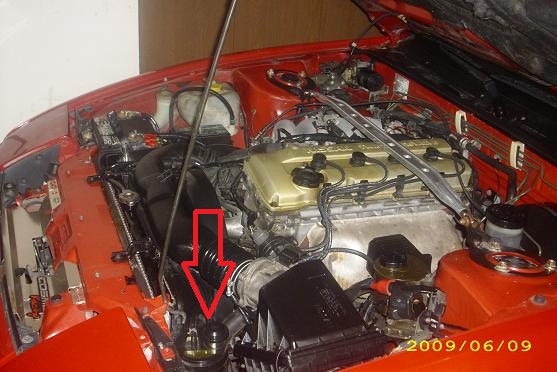 2. Remove all hoses from the cannister, trace them back to their sources & cap off nipples using 4 or 6mm vacuum caps. **NOTE: Your EGR system is useless at this point, so you may as well get rid of it as well  3. Using 10mm socket or wrench, remove cannister and bracket. 4. Jack the rear of your car & place jack stands under the subframe or jacking pads. 5. Locate the 4 hardlines running along the floorpan inboard of your RH frame rail. One is your rear brake line that goes to a splitter to each caliper, two are larger lines- these are your fuel feed/return line. 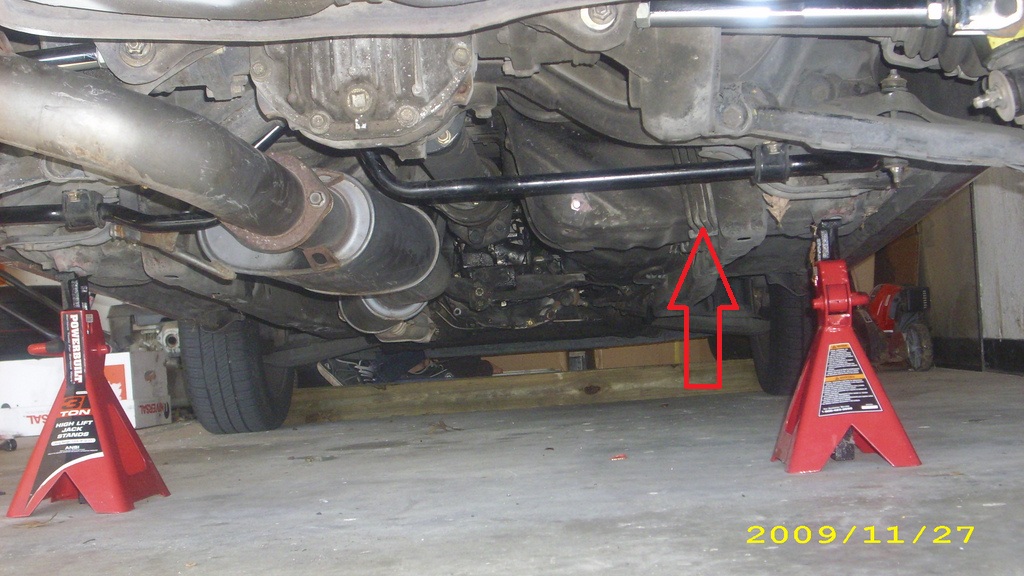 The last smaller line (the most inboard IIRC) is the evap line from the charcoal cannister. You will see a rubber hose coming off of it going to a check valve (pictured below). The check valve is bolted to the underside of the car with 2 10mm bolts: 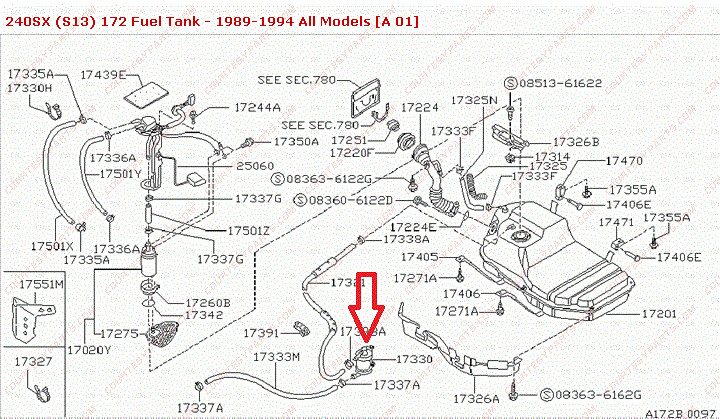 **NOTE: THIS IS A ONE-WAY CHECK VALVE. ONCE YOU REMOVE THE VACUUM LINES FROM THE CANNISTER IN THE ENGINE BAY, THERE IS NO LONGER VACUUM ON THE FUEL TANK TO RELIEVE NEGATIVE PRESSURE CAUSED BY FUEL PUMP SUCTION, OR IN-TANK FUMES. IF YOU DO NOT REMOVE THE CHECK VALVE VACUUM LINE & VENT THE TANK TO ATMOSPHERE, IMPLOSION OR EXPLOSION COULD RESULT!!! 6. Remove the check valve if you desire to get rid of all plumbing completely, or simply disconnect the 1/4" hose going from the check valve to the fuel tank. ** If you did not remove the tank from the car, the evap hose nipple can be a real PITA to get to: 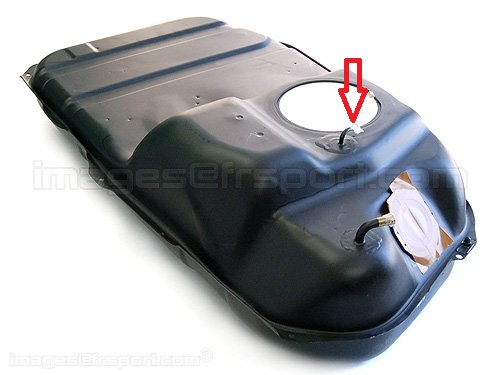 7. Remove the hose from the evap nipple on the tank, or install a male/male 1/4" barb fitting into the hose (from check valve to fuel tank) to extend it if you left it connected. 8. Once you have extended or replaced the hose with a longer length, run it to a location that is generally safe from debris/obstructions. I ran mine toward the back of the tank along the lip: 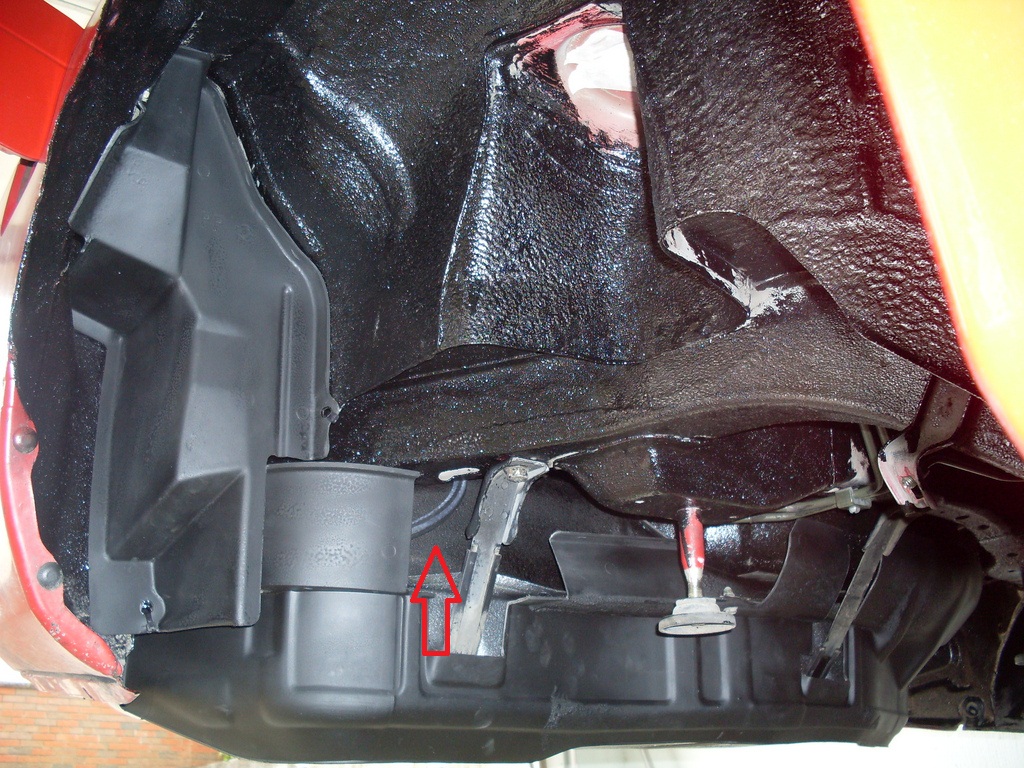 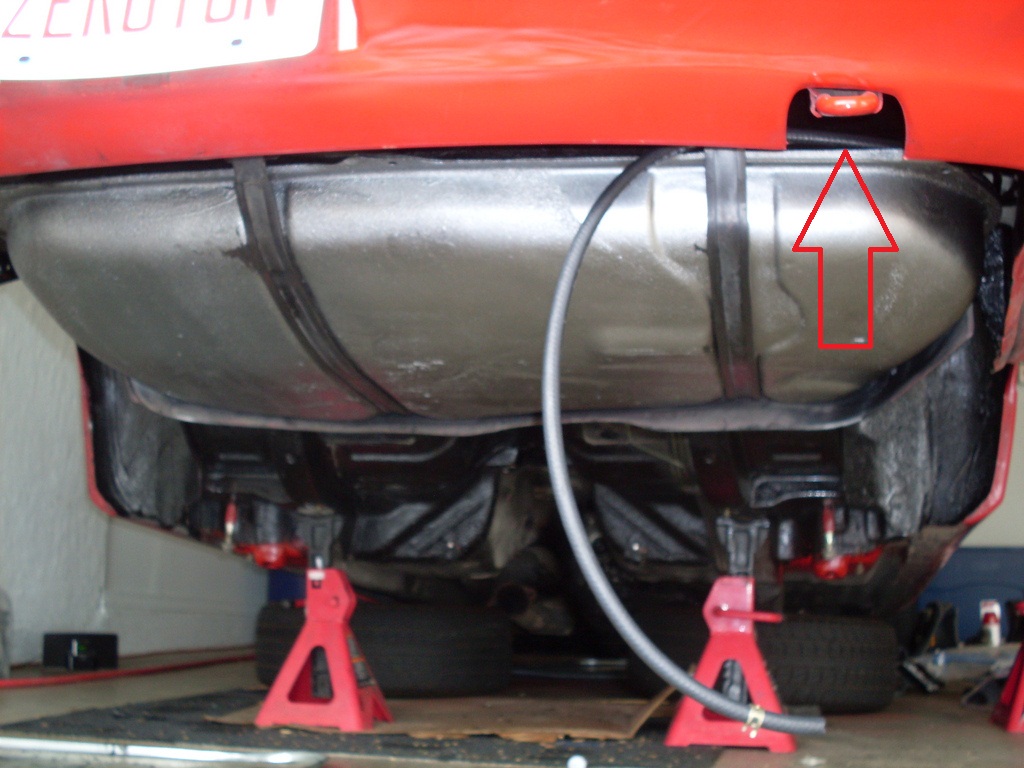 9. Cut hose to desired length, put a small filter on the end to keep debris & critters out (filters are in lawnmower/small engine section of any auto parts store); and secure with adel clamps or zipties. 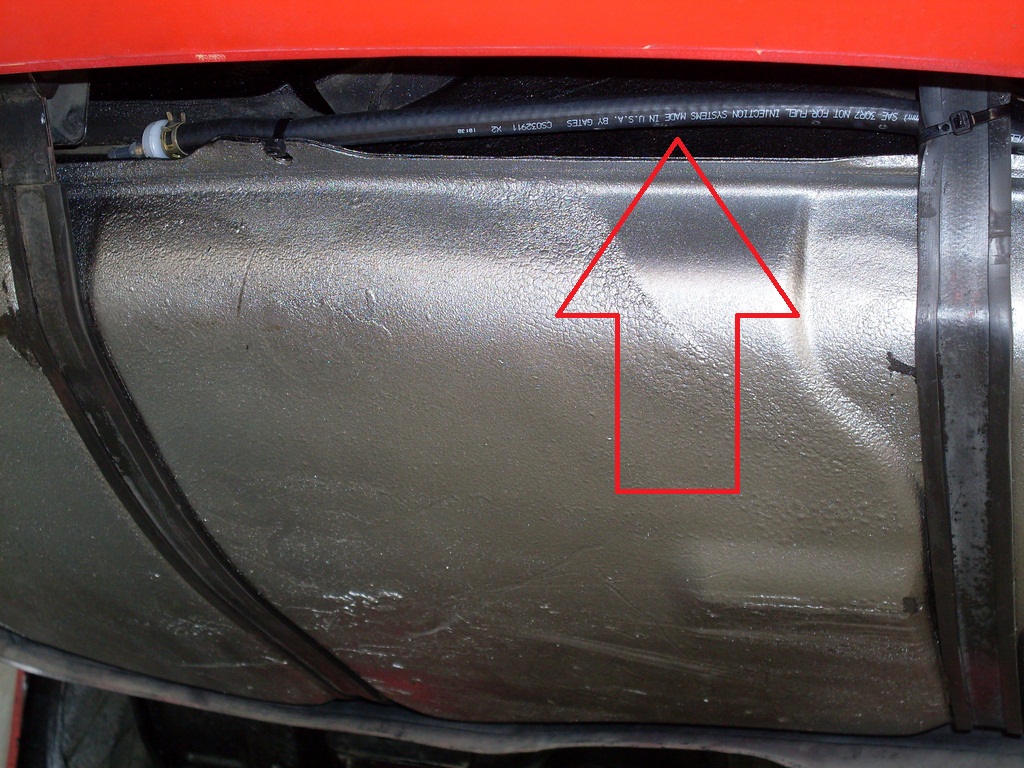 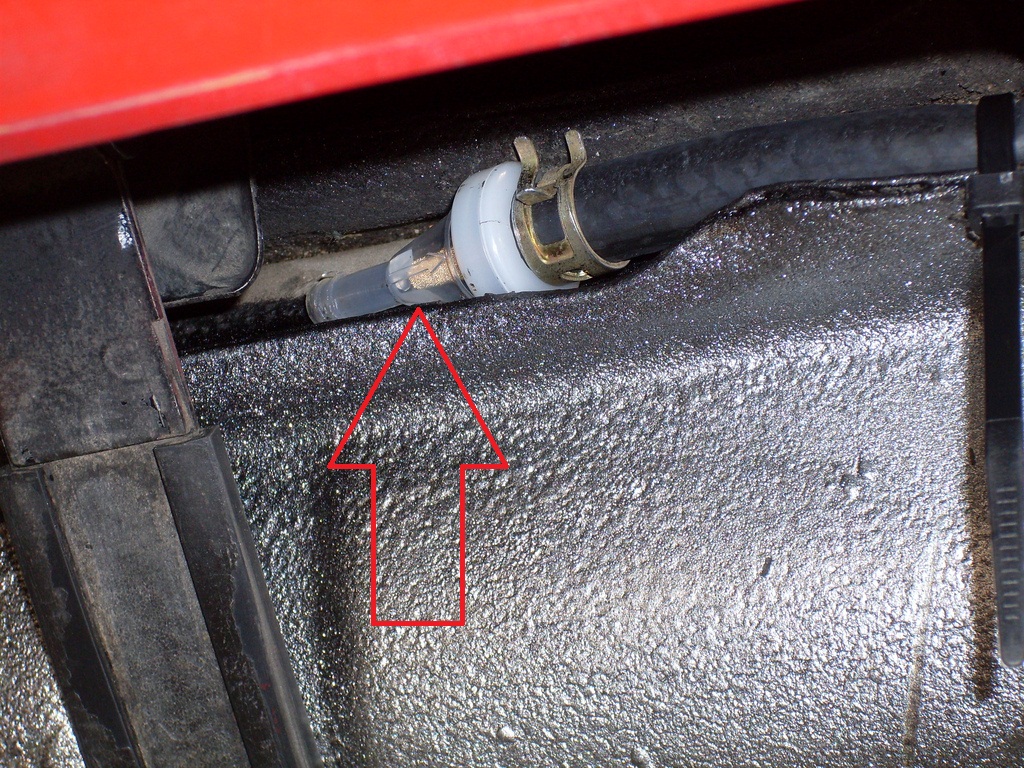 At this point, you are done. Remember, the tank NEEDS to be vented in some way, shape or form!!! **If you left the hardline in place, place vacuum caps over both sides to keep debris/critters out... Or just to be sure no residual fumes will find their way into the engine bay. Removing the hardline is self-explanatory; therefore not covered. For those of you with no clue how to get it out; DO NOT do anything beyond step 1  --Mike
__________________

|
|
|

|
| Sponsored Links |
|
|
#3 |
|
Post Whore!
 Join Date: Aug 2009
Location: Rancho Cucamonga
Posts: 3,693
Trader Rating: (55)
 Feedback Score: 55 reviews
|
wouldn't removing the check valve and leaving whatever line that goes from the nipple on the tank to the check valve be venting to the atmosphere?
__________________

|
|
|

|
|
|
#4 |
|
Nissanaholic!
 Join Date: Jun 2007
Location: Kathleen, GA
Age: 50
Posts: 1,938
Trader Rating: (0)
 Feedback Score: 0 reviews
|
If I understand the question, yes it would. But I still would recommend extending the line out to somewhere that is not directly under the car... somewhere easier to get to in order to inspect/replace the filter once in a while; and/or to minimize fumes going into the passenger compartment.
__________________

|
|
|

|
|
|
#7 |
|
Great write-up. I've been wondering what to do about venting my gas tank for a while now. Do you know if using a vented gas cap and just blocking the stock venting hose would do the same thing?
|
|
|
|

|
|
|
#8 | |
|
Nissanaholic!
 Join Date: Jun 2007
Location: Kathleen, GA
Age: 50
Posts: 1,938
Trader Rating: (0)
 Feedback Score: 0 reviews
|
Quote:
The key is that the tank needs to be vented- How that is accomplished is limited only to the ingenuity of the person doing the work=)
__________________

|
|
|
|

|
|
|
#11 | ||
|
Nissanaholic!
 Join Date: Jun 2007
Location: Kathleen, GA
Age: 50
Posts: 1,938
Trader Rating: (0)
 Feedback Score: 0 reviews
|
Quote:
Quote:
 Not sure how correct that is, but I personally always try to err to the safe side.
__________________

|
||
|
|

|
|
|
#13 | |
|
Leaky Injector
|
Quote:
|
|
|
|

|
|
|
#14 |
|
Nissanaholic!
 Join Date: Jun 2007
Location: Kathleen, GA
Age: 50
Posts: 1,938
Trader Rating: (0)
 Feedback Score: 0 reviews
|
Your reading comprehension skills are amazing.
The key term here is COULD If you just plug a one-way system with an electric pump sending fuel upstream, there will be negative pressure in the tank... It could implode and/or cause the pump to cavitate. I have seen both. Now- Read carefully- not WILL implode, but COULD implode. Further, if you seal off the tank without either venting to atmosphere or intake vacuum (or any number of other ways) to keep excess fumes out of the tank; it could cause explosion (say due to rear end impact). Now read carefully again: Not WILL explode, but COULD explode. I'm not sure if you are aware of how flimsy the average OEM Nissan fuel tank is. If you think sealing it is fine, then by all means do so. I never said anyone MUST remove the check valve. What I DID say was that the tank needs to be able to vent in some way shape or form in order to purge excess fumes & equalize internal pressure. Personally, I don't give 2 fucks about emissions, but I give 2,000,000 about safety. On that note, I will not put a writeup out here for several thousand members to digest without advising of any potential dangers involved. I have a friend with 70% of her body burned... Her dad built her a car & sealed the fuel tank... It wasn't designed to be sealed. She got rear-ended- Tank went boom. If you still think it's negligible, then good for you. Anyone else here does as well- no problem... go start a "sealing the tank is perfectly safe, even though it isn't designed to be" writeup and see how many kudos it receives.
__________________

|
|
|

|
|
|
#15 |
|
Leaky Injector
|
If you go read the FSM you will see that the valve (if functioning) lets air/fumes go both directions. Therefore no implosion.
The gas cap is responsible for relieving the vacuum inside the tank |
|
|

|
|
|
#16 | |
|
Nissanaholic!
 Join Date: Jun 2007
Location: Kathleen, GA
Age: 50
Posts: 1,938
Trader Rating: (0)
 Feedback Score: 0 reviews
|
Quote:
 It's designed to be a sealed, one-way system for fuel vapors, hence the term CHECK VALVE. Once you open the line that normally would go to the cannister to atmosphere, it no longer functions as designed; and fuel vapors have no way to leave the tank (explosion hazard). I get it- according to the drawing, air is able to flow back into the tank through the check valve; but once the seal is broken, it will not suddenly become a vacuum relief valve. Look at the big picture diagram: 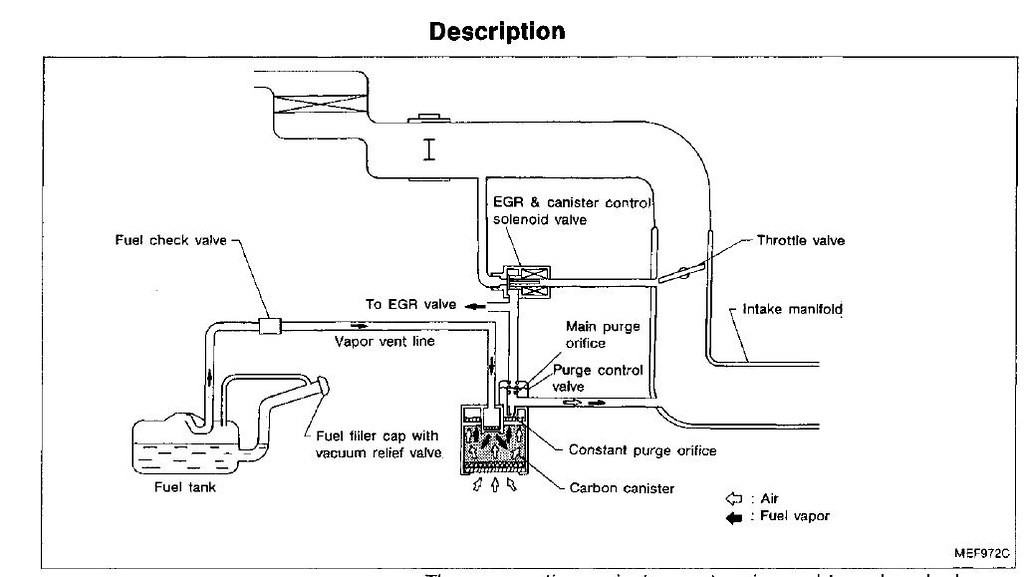 The cap...  You know that WHOOSH you hear when you take the gas cap off to fill it? That's the vacuum pressure being relieved... Not air rushing out... The cap is not nearly as effective as you may think... Sometimes, it even takes sitting thru the night to equalize the pressures... and to fully function as advertised, the system needs to be sealed as designed. If you're running a fairly powerful car with a gnarly fuel demand, I assure you, you can't just seal the tank off & expect the cap to be able to cope... It won't happen. Really, this is all a moot point because I said that the methods of deleting the cannister are only limited to the ingenuity of the person doing the work... I did it a certain way, and passed off the safety concerns I had with respect to anyone who may read it. I get the impression you are trying to start an argument and/or split hairs vs. put out anything factual. Again, please feel free to do a writeup of your own. Irregardless, my method of deleting the evap system is clean & effective; and in the end, that's all that should matter..
__________________

|
|
|
|

|
|
|
#17 |
|
So on a boosted engine, I get rid of charcoal cannister, hook the vaccuum line from the check valve back up to the vaccuum port on the intake with another 1 way check valve to prevent boost from pushing back, how does that sound? But the charcoal cannister has a purge valve, I assume set to "purge" at a certain level of vaccuum/pressure...without it there, couldn't you also then still run into the problem of sucking the tank too hard when driving around in high vaccuum conditions (light cruise for example)?
Don't get me wrong, I will be venting to the atmosphere as you did in your writeup with a filter mounted up high and as far away from anything flammable, but it'd be even easier if you could literally just delete the cannister and hook up the vaccuum line from the tank back up to the engine. Last edited by afracer; 02-28-2013 at 09:49 PM.. |
|
|
|

|
|
|
#18 |
|
Nissanaholic!
 Join Date: Jun 2007
Location: Kathleen, GA
Age: 50
Posts: 1,938
Trader Rating: (0)
 Feedback Score: 0 reviews
|
There are several ways to do it... As long as there is a way for it to "breathe," it will be fine. I did it this way for engine bay cleanliness. Because of the extra fuel vapor that can be sucked out of the fuel tank & routed to the intake for combustion, other people go different routes...
The canister vacuum line is hooked up to the TB, not the charge piping so it never really sees boost. If you are wanting to keep the added fuel vapors to your mixture, I'd recommend you just keep the evap system intact, and maybe just do some custom relocation or dress-up. As far as adding additional check valves etc, I won't speculate as to how; but I'm sure it can be done.
__________________

|
|
|

|
|
|
#21 | |
|
Post Whore!
 |
Quote:
The fuel check valve works as an equalizer for the fuel tank. On hot summer days, there will actually be positive pressure that will accumulate inside the tank. If you only install a one-way valve (vacuum) or keep the fuel check valve but block off the fuel vent, you will have problems. And by problems I mean premature fuel pump failure. The fuel check valve will release a little bit of fuel vapor when the pressure exceeds X amount of psi. The fuel cap is vacuum only for S13's. If you vent to atmosphere with no fuel check valve installed, then you basically have an open system and moisture will creep into the tank and then you can say hello to a rusty S13 fuel tank for me. If you want to block off the fuel vent, you can, but you must install an OEM S14 fuel cap because that acts as a two-way valve just like the fuel check valve. Personally, I have an S14 fuel cap and a functioning fuel check valve so that way if one fails, the other is there as a fail-safe. I left the factory hard lines alone so it vents out right where the charcoal canister was. Been running it like this for 6 years and no IMPLOSION/EXPLOSION has occurred (like you are implying).
__________________

|
|
|
|

|
|
|
#23 | ||
|
Nissanaholic!
 Join Date: Jun 2007
Location: Kathleen, GA
Age: 50
Posts: 1,938
Trader Rating: (0)
 Feedback Score: 0 reviews
|
Quote:
Quote:
Had no idea S14 cap is a 2-way... Added to the list.
__________________

|
||
|
|

|
|
|
#24 |
|
Post Whore!
 |
No. The S14 has the two-way gas cap and the fuel check valve.
__________________

|
|
|

|
|
|
#25 |
|
Leaky Injector
|
Just plug the evap line at the tank or at the firewall area and use an S14 gas cap.
Don't run the evap line directly to the throttle body because anytime the tank builds pressure (even if the car is off) it will vent through there... Gee why is my car so hard to start on hot days....? |
|
|

|
|
|
#26 |
|
Leaky Injector
Join Date: Feb 2017
Location: California
Age: 27
Posts: 71
Trader Rating: (0)
 Feedback Score: 0 reviews
|
Being this is my first 240sx (S14), KA24.
I've replaced the crank seal, and since everything looks clean up front I've decided to go forward with EGR and Charcoal Canister delete. I traced the fuel from canister to passenger side under fire wall and there is the lines.. QUESTION is. Its ok for me to have the fuel line vent from fire wall? |
|
|

|
|
|
#27 |
|
Zilvia Junkie
 |
What S14 gas cap has the 2 way valve? Right now I have at least 4 part number that fits on the S14 and some seems to apply to the S13 as well:
-17251-79912 that seems to fit the S13 too and is superseded by: 17251-F9912 -17251-79913 that is superseded by: 17251-79914 |
|
|

|
|
|
#28 |
|
Post Whore!
 Join Date: Jul 2005
Location: South Florida
Age: 38
Posts: 4,649
Trader Rating: (17)
           Feedback Score: 17 reviews
|
I need to bring this back because its part of 240sx that I have no clue how to deal with.
haaaaalp My questions are for S14 only Right now in a swap I have the 3/8" fuel line typical running to the engine bay from the little plastic box in the bumper, like we always used to do for swaps And its the same as the last 20 years- the tank never seems over pressure, or under pressure, and the fuel demands of the engine are huge. So I know its sucking air from somewhere (that line?)... Into that black box? I'll bet theres no filter in there. And I read above S14 caps are also breathing, there must be a filter inside them at least? In any case. Atmospheric air contains water, and dirt, which should be eliminated or controlled before the air is allowed into the fuel tank, the E85 (drinking alcohol or "ethanol" etoh) will absorb any water and if it can absorb enough it will turn to shit and make a huge mess of everything "E85 disaster". That's why you can't just put a hole in the tank to relief pressure when using E85. It needs to be checked... but the check system can't ever be allowed to fail so make it redundant, use at least two lines with checks in case one fails. I think I solved it but I have a feeling the cap isn't 100% sealed at rest, and neither is mystery box. So I have a terrible feeling that I will need to disable the fuel cap vent and install an aux vent with a desiccant/drier to achieve a fully stable container of E85 for long term storage, or at the very least a checkvalve to prevent air from exchanging with atmosphere. how doesn't this issue affect regular flex trucks? Are the fuel caps 'better' checkvalves? Are there warning in the owner's manual about leaving E85 in a fuel tank for long duration? are the tanks so well sealed up that air cannot enter unless it is replacing air, and that's all the air that is allowed. For years that's what I assumed that 3/8" line did, one-way valve for atmospheric air to enter the fuel tank quickly. I am okay with that kind of system but trusting the 20 year old stuff to work that well without testing it, to be 99% air tight to protect alcohol seems like rolling the dice. I don't wana just dump E85 in the tank without first testing it. So I am going to apply a positive pressure the tank manually and see what happens I guess. Only a couple psi max of course. And the same with vacuum if I can manage somehow. I suppose this is the only way to discern behaviors from scratch. Any advice is appreciated and I'll share what I find if I ever get around to doing this. I might just goto a junkyard and pull apart the tank of a flex fuel truck just to see. Oh yeah that'll be much easier than looking in the service manual... Last edited by Kingtal0n; 08-07-2019 at 02:31 PM.. |
|
|

|
|
|
#29 | |
|
Zilvia Addict
 Join Date: Apr 2011
Location: Near Pittsburgh, PA
Posts: 634
Trader Rating: (1)
 Feedback Score: 1 reviews
|
Quote:
I’ve retained a sealed EVAP system on S13’s. Anyone else wanting to retain EVAP emissions on an S13 I can probably post some stuff in here. Did it to a SOHC and will be doing it soon to a DOHC so I’ll be able to speak for both. You trying to do something similar, but on an S14? |
|
|
|

|
|
|
#30 |
|
Post Whore!
 Join Date: Jul 2005
Location: South Florida
Age: 38
Posts: 4,649
Trader Rating: (17)
           Feedback Score: 17 reviews
|
I have an s14 I want to put E85 in the factory tank but I have a feeling its going to melt the seals and create a leak. So really I just want to understand fuel tanks that keep E85 in it (flex fuel systems) I guess so I can be re-invent the 25 year old apparatus into a modern flex fuel system... including the fuel tank and venting somehow... might have to get a spare one and do some magic to it.
|
|
|

|
 |
| Bookmarks |
| Thread Tools | |
| Display Modes | |
|
|